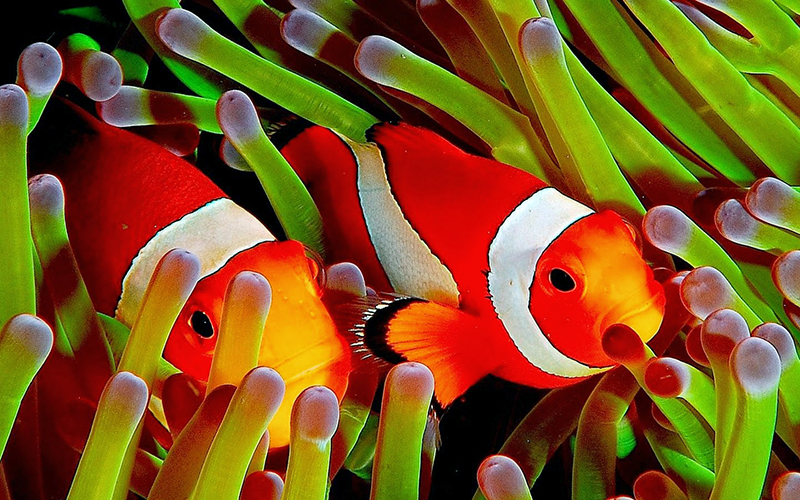Pea Puffers Care Information – Tank Setup, Weight-reduction plan & Breeding
The Dwarf Pufferfish, also referred to as Pea Puffer or Pygmy Puffer, is a weak freshwater species and is a well-liked aquarium fish. Pea Puffers are discovered within the wild, forming giant teams to breed and prey on smaller fish, contradictory to typical pufferfish conduct.
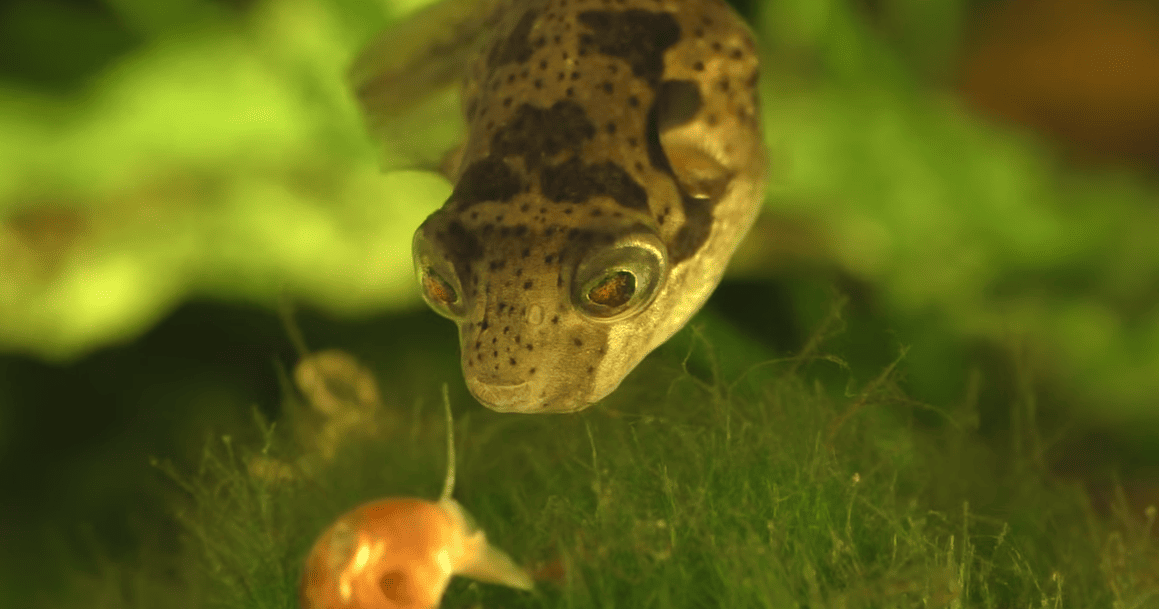
Pea Puffers have discovered their manner into the aquarium commerce for his or her distinctive look and puffing mechanism, which refers to their potential to gulp air and inflate their our bodies within the face of hazard.
Nevertheless, with growing demand and overfishing, the Pea Puffer inhabitants has quickly declined of their pure habitats.
On this article, we’ll talk about all the small print that you must know to provide care to your Pea Puffer or a gaggle of Puffers. We’ll largely concentrate on technical particulars and obligatory suggestions that will make your job simpler.
Pea Puffers Overview
The marine pufferfish and the Pea Puffers are separate species of the identical household. They’re one of many 27 pufferfish species tailored to freshwater. Nevertheless, Pea Puffers are in a position to adapt to barely brackish water if required.
The Dwarf Puffers are thought-about a weak species on the IUCN Crimson Checklist on account of damming, overfishing, and deforestation.
As an aquarist, you could perceive that the Pea Puffers require a sophisticated stage of care when it comes to diet, tank upkeep, and water high quality.
| Info Chart | Pea Puffer |
| Scientific Title: | Carinotetraodon travancoricus |
| Household: | Tetraodontidae |
| Care Degree: | Average to Superior |
| Temperament: | Semi-aggressive |
| Shade: | Greenish-brown coloration with patterns and markings |
| Lifespan: | As much as 5 years |
| Measurement: | Round 1 to 1.5 inches |
| Weight-reduction plan: | Carnivorous food regimen |
| Minimal Tank Measurement: | 5 gallons for a single fish |
| Temperature: | 72 to 82 F (22 to twenty-eight C) |
| Water Circumstances: | pH 7.2 to 7.5 Reasonably exhausting water |
| Tank Mate Compatibility | Will be saved alone or in a gaggle. Different peaceable fish species make optimum tank mates. |
Look
With a most size of 1.5 inches, Pea Puffers are one of many smallest pufferfish on the earth. Though Pea Puffers exhibit sexual dimorphism, each men and women are primarily greenish-yellow, with darkish spots and iridescence patches on their spherical and rectangular our bodies.
Their dorsal fins are situated barely backward and reverse to the anal fins. Each are spherical and quick. The pectoral fins of puffers, then again, are fan-shaped and barely emarginate. The most important fin of Pea Puffers, the tail fin, is elongated and has a vertical edge.
Females of the Pea Puffers are extra spherical in form and have a light-colored underbelly. In addition they lack an iridescent blue-eye wrinkle sample current in some males.
Varieties of Pea Puffers
Whereas Pea Puffers are a selected species, there exists a number of small pufferfish species that seem comparable. A few of them are:
Bumblebee Puffer
Native to Indonesia, the Bumblebee Puffers are a bit bigger (2 inches) than Pea Puffers. They’re extra aggressive and aren’t appropriate for group tanks. They’ve a extra yellowish hue on their physique.
Crimson-tailed Puffer
The Crimson-tailed Puffer is one other pufferfish native to Indonesia, which has a darker physique and pink tail and eyes. Patterns and spots are seen all through its physique, and it reveals shoaling conduct within the wild.
Spot-Fin Puffer
Rising to about 1,5 inches, the Spot-fin Puffer has a pink eye, noticed physique, and fins. They’re peaceable in nature and like residing and looking in teams of at the least 6. In addition they are native to Indonesian rivers.
Lifespan of Pea Puffers
The standard lifespan of Pea Puffers is 3 to five years.
Within the wild, the lifespan of Pea Puffers is negatively impacted by:
- Predators: Bigger fish, birds, and different aquatic predators feed on Pea Puffers.
- Habitat destruction: Deforestation and air pollution typically destroy the pure habitat of Sea Puffers.
- Competitors: Pea Puffers have to compete with different giant or small fish species for meals within the wild.
- Illness and Parasite: Wild Pea Puffers are extra prone to ailments and parasites than these in synthetic waters.
Most of those points are non-existent in synthetic water. Nevertheless, the lifespan of domesticated Pea Puffers is negatively affected by:
- Poor water high quality: Pea Puffers are very delicate to adversarial water high quality and parameter adjustments.
- Improper Weight-reduction plan: Being carnivorous, Pea Puffers depend on your choice of food regimen selection. Not feeding dwell or frozen meals can lower their lifespan.
- Overcrowding
- Tank Aggression
- Lack of Hiding Spots
Pea Puffers Measurement
Pea Puffers can develop As much as 1.5 inches in well-maintained tanks with correct diet. The components that affect their lifespan, can also contribute to a decreased maturity size of Pea Puffers.
Preserve the following tips for extra optimistic outcomes:
- Tank dimension: Regardless of Pea Puffers being small fish, they want ample house to swim and discover. Present a tank dimension of at the least 30 gallons for a gaggle of 6 Pea Puffers for optimum development.
- Water high quality: Common water adjustments (about 35% each 1-2 weeks) and using highly effective organic and mechanical filtration promote the expansion of Pea Puffers. Additionally, preserve optimum water parameters like pH, hardness, and nil ammonia and nitrite.
- Provide a diverse and correct carnivorous food regimen.
- Feeding frequency: Feed in small quantities a number of occasions a day to match their quick metabolism.
- Hiding spots: Present ample hiding spots within the types of dwell vegetation, rocks, driftwood, and caves.
- Cut back stress: Stress negatively impacts development. Guarantee a stress-free atmosphere by decreasing sudden parameter adjustments and eradicating aggressive tank mates.
- Persistence: Pea Puffers develop at a a lot slower price than most freshwater fish. Be affected person and comply with the information.
Pure Habitat and Origin
Pea Puffers are native to the Western Ghats of Peninsular India. They’re discovered within the calm rivers and lakes of Kerala and Karnataka. As a migratory species, they typically transfer across the river techniques on this area to breed and supply meals.
This pufferfish species inhabits densely vegetative waters with substrates comparable to gravels, rocks, clay loam, and sand. In addition they are discovered inhabiting paddy fields, ditches, and ponds in these areas.
Within the wild, Pea Puffers are discovered to desire dwell vegetation, comparable to Duckweed and Amazon Frogbit.
Pea Puffers Care & Tank Set-Up
Let’s now dive into extra superior discussions concerning the care and tank necessities for Pea Puffers. Earlier than we begin, all the time do not forget that whereas we’ll attempt to provide the most correct info, every particular person fish has its personal necessities and desire. Remark is the important thing.
Tank Measurement and Specs
On this part, we’ll talk about the tank dimension and tank specification necessities for Pea Puffers.
Optimum Tank Measurement for Pea Puffers
The minimal tank dimension requirement for Pea Puffers is 5 gallons for a single fish. With the introduction of a number of puffers, the minimal necessities additionally improve in virtually a geometrical development.
Nevertheless, the really useful tank dimension is way increased. You shouldn’t go together with something under 10 gallons for a single puffer and 20 for a gaggle of three. For extra members, improve the tank dimension as required.
A bigger tank dimension additionally helps them carry out their pure, quirky behaviors of glass browsing and substrate play. Glass browsing is when your Pea Puffer needs consideration and follows your actions by browsing within the tank. Substrate play, then again, is a territorial conduct of burrowing and arranging substrates.
Tank Form for Pea Puffers
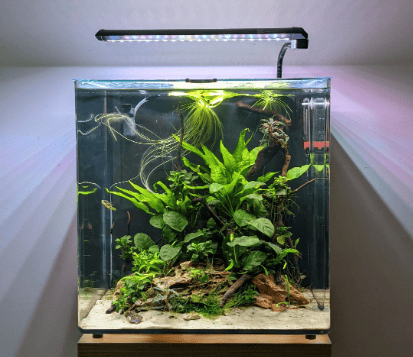
You’ll be able to preserve your Pea Puffers in any tank form. However, as they’re lively swimmers and love observing the actions outdoors of the tank, horizontal tanks are best suited for them.
An extended tank additionally permits you to be extra inventive with aquascapes and hiding spots, which Pea Puffers desire to have of their tanks.
When selecting an even bigger tank for a number of puffers, concentrate on the size greater than the width and top. An ordinary 5-gallon aquarium has the next basic dimensions:
Size: 16 inches
Width: 8 inches
Peak: 10 inches
Filter Kind
Pea Puffers have a average bioload for his or her dimension. Which means that they produce a major quantity of waste, each within the types of wasted meals and poop. With extra bioload, poisonous parts within the aquarium, comparable to ammonia, nitrite, and nitrate, additionally turn out to be danger components.
To interrupt these chemical compounds down, helpful micro organism and highly effective filtration are vital.
For Pea Puffer tanks, hang-on again (HOB) filters are enough and really useful. With canister filters being extra highly effective and producing a excessive water circulation, these merchandise aren’t appropriate for small Pea Puffers.
A sponge filter could also be included as an extra filtration software, however shouldn’t change the HOB with mechanical and organic filtration talents.
The very best filter media for Pea Puffers are:
- Filter Sponge: Light filter sponges can present the preliminary filtration for Pea Puffer tanks.
- Organic Media: Ceramic rings and bio-balls must be added to the HOB.
- Mechanical Filter Pad: Embrace finer mechanical filter floss within the HOB to lure natural particles.
Substrate
The very best substrates for Pea Puffer tanks are those that they’re habituated to in nature. They typically create burrows within the substrate or rearrange them in a territorial manner. Due to this fact, the perfect substrates embody:
- High-quality sand: Carefully resembling the river beds, tremendous sands are a wonderful substrate selection for Pea Puffers. They’ll exhibit their burrowing conduct with out harming their delicate undersides.
- Easy gravel: Small, smooth-edged gravels will be chosen as substrate selections for Pea Puffers. Select gravels that aren’t giant and don’t have sharp edges, because the puffers wish to discover and transfer them round.
Naked backside tanks can also be an environment friendly choice, however we don’t advocate that to hobbyists.
What number of Pea Puffers in a 20 Gallon Tank?
A gaggle of 6 Pea Puffers can dwell in a 20-25 gallon tank.
Water Parameters for Pea Puffers
Pea Puffers are fairly delicate to water parameters and toxin spikes. Due to this fact, it’s vital to keep up optimum water parameters always.
Water Temperature
Pea Puffers desire a comparatively hotter water temperature of 72 to 78F. Retaining the temperature inside that vary helps with sustaining their metabolic price and total exercise stage. Enormous deviations in water temperatures can result in temperature shock and behavioral adjustments in your Pea Puffer.
Decreased urge for food, compromised immune system, and breeding points are also prevalent with temperature disparity.
A number of suggestions for sustaining water temperature embody:
- Utilizing a strong heater with temperature management.
- When altering water, precondition it to match the aquarium temperature.
- Change water steadily to cut back water temperature.
- Enhance the water circulation if you wish to settle down the water. Enhance circulation on the floor stage for finest outcomes. Use a circulation generator.
Water Movement Charge
Pea Puffers are native to calm rivers and lakes, the place they aren’t uncovered to severe water currents. A water circulation price of 10 GPH is greater than ample to maintain wholesome Pea Puffers. That’s why HOB filters are the only option for puffer tanks.
Nevertheless, for those who use a canister filter or have a circulation generator put in, right here is how one can modify the water circulation price:
- Set up filters with adjustable filter circulation to extend or lower the water circulation price as required.
- Buy a circulation reducer in case your filter doesn’t supply a circulation adjustment mechanism.
- Modify or use completely different output equipment to keep up the circulation or disperse it over a higher space.
- Use vegetation and decorations to create boundaries in opposition to the circulation.
- Add a pre-filter sponge to stop Pea Puffers from getting sucked into highly effective filters.
- Place and rotate the filter in a special route to cut back water circulation.
pH Ranges
Pea Puffers desire a reasonably primary pH of seven.2 to 7.5. It helps them preserve their acid-base steadiness within the physique, which influences the conduct of blood and physique fluids. As well as, pH imbalance might trigger points with gill operate and extracting oxygen from the water.
Ion regulation points and stress stage improve are different main signs of pH imbalance in water.
To take care of a average pH stage, take into account:
- Commonly testing for pH ranges in your fish tank. Hold testing kits helpful and attempt to preserve a routine.
- Realizing your water sources and testing them earlier than mixing them with tank water. Water sources typically change, and that may trigger a pH spike.
- Utilizing pH buffering substrate like coral or aragonite. They often improve the pH to an appropriate stage.
- Partial water altering. Partial water adjustments may also help preserve optimum pH ranges.
- Utilizing driftwood and Indian Almond leaves. These can launch tannins within the water to cut back pH ranges.
Whereas it’s important to realize an optimum pH stage, it’s extra vital to maintain it. Whereas your fish will tolerate a number of levels of deviation, they wouldn’t be capable of survive sudden spikes.
Water Hardness
Pea Puffers thrive on reasonably exhausting water that falls inside the vary of 5 to fifteen dGH. GH and KH testing kits are usually used to measure water hardness.
Inaccurate water hardness typically leaves the Pea Puffers with stress and well being points. They could additionally develop osmotic stress, the place an imbalance of solutes within the physique and exterior atmosphere happens.
To extend water hardness, add commercially out there mineral components to the water. And to cut back hardness, attempt mixing water sources or utilizing water softeners.
Pea Puffers Tank Panorama
Hiding locations are vital for the well-being of Pea Puffers. Being native to rivers with dense vegetation, they like exploring and hiding behind dwell vegetation, driftwood, and {smooth} rocks.
Finest Vegetation for Pea Puffer Tanks
Most vegetation with gentle and broad leaves are appropriate for Pea Puffers. A few of them might embody:
- Java Moss: A hardy and low-maintenance species of vegetation that may be anchored to driftwood.
- Java Fern: Properly-suited for low-light circumstances, this plant has broad, inexperienced leaves to cover the puffers.
- Anubias: Sluggish-growing plant with thick leaves, superb for Pea Puffers.
- Amazon Sword: Bigger vegetation so as to add a lush to the tank.
- Water Sprite: Discovered within the pure Pea Puffer atmosphere, this fast-growing plant improves water high quality.
- Duckweed: Additionally present in a pure setting with Pea Puffers, this plant offers shade and canopy.
Worst Vegetation for Pea Puffer Tanks
There aren’t any such frequent aquarium vegetation which might be dangerous to Pea Puffers.
However, you need to keep away from,
- Vegetation that may simply be uprooted, like Vallisneria.
- Vegetation with skinny leaves, like Cabomba.
- Small and delicate vegetation, like Child Tears.
- Weak carpeting vegetation, like Hairgrass.
Decorations for Pea Puffers Tanks
Decorations are used to imitate the pure aquascape of the inhabiting fish species. In case of Pea Puffers, decorations might embody:
- Driftwood: Gives hiding spots for Pea Puffers.
- Rocks and Caves: Additionally gives nice hiding spots and shelter.
- Dwell Vegetation: Enhances visible enchantment, offers shelter, and permits exploration.
- Indian Nearly leaves: Maintains water high quality and permits Pea Puffers to nimble on them.
- PVC Pipes: Creates extra hiding spots.
- Easy Toys.
Lighting for Pea Puffers Tank
You don’t have to decide to any particular lighting setting to maintain Pea Puffers. As you could be together with dwell vegetation to your aquarium, be sure that to make use of brighter white lighting. Nevertheless, attempt to keep away from intense lighting, as Pea Puffers are from waters with subdued and dappled lighting.
If doable, take into account pure lighting to comply with the day-night cycle. If not, use timers to supply at the least 8-10 hours of lighting.
Feeding Pea Puffers
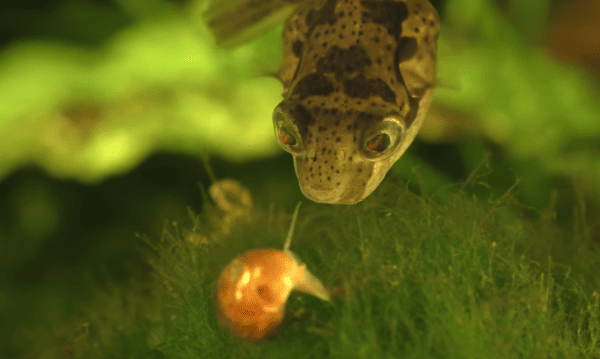
A carnivorous food regimen is crucial to maintain your Pea Puffers wholesome. Listed here are a number of dietary choices which might be appropriate for a similar.
Finest Weight-reduction plan for Pea Puffers
Provide shrimp, daphnia, mosquito larvae, and bloodworms in dwell or frozen kinds to meet their pure urge for food.
The mouths of Pea Puffers are designed to interrupt into invertebrates, particularly snails. And they need to be a necessary a part of their food regimen. Provide small, soft-shelled snails like Malaysian Trumpet Snail or Bladder Snail.
- Microworms or Vinegar Eels
These small dwell meals choices will be profitable for mature Pea Puffers.
Newly hatched brine shrimps are an awesome choice for juvenile Pea Puffers.
Commercially out there carnivorous pellets comprise excessive protein and different dietary parts.
How typically must you feed Pea Puffers?
As they’ve a fairly excessive metabolic price, feed at the least thrice a day in small parts to your Pea Puffers.
Pea Puffers Conduct and Temperament
Within the wild, Pea Puffers are seen to be swimming in giant teams. However, on account of house confinement and territorial behaviors, they will present semi-aggressive conduct in synthetic waters.
They’re predominantly curious creatures and like to always discover their atmosphere, vegetation, decorations, and new fish. However, they don’t significantly develop a liking in direction of different curious creatures and will chase them away.
Pea Puffers typically nip on different fish. Both because of their aggression or mistaking them as meals, their predatory intuition typically proves dangerous to different non-aggressive species.
Like different pufferfish species, Pea Puffers additionally relaxation close to the substrate with their physique partially burrowed contained in the sand. They typically seem extra pale and flatter when resting. Nevertheless, they swim across the floor throughout the day searching for meals or to gulp air.
Are Pea Puffers lone or social in nature?
Pea Puffers aren’t social in the identical manner as education fish however they will kind free teams within the wild to remain secure.
Pea Puffers Tank Mates
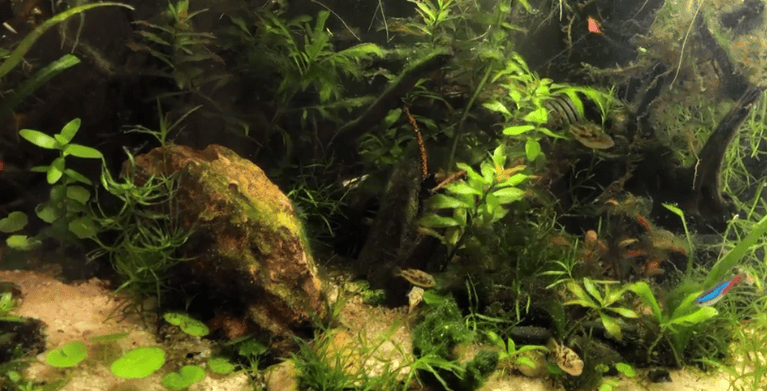
The perfect and unhealthy tank mates for Pea Puffers are mentioned on this part.
Preferrred Pea Puffer Tank Mates
Largely peaceable, non-aggressive, and similar-sized fish species are appropriate for Pea Puffers. Some examples of that will embody:
- Small education fish, comparable to Ember Tetra, Celestial Pearl Danios, and Rasboras.
- Otocinclus Catfish. Small and peaceable algae-eaters.
- Kuhli Loaches. Small, peaceable, nocturnal species that coexist fairly simply with Pea Puffers.
- Dwarf shrimp species, comparable to Cherry Shrimp and Amano Shrimp, will be saved with Pea Puffers.
Dangerous Tank Mates for Pea Puffers
It’s typically finest to keep away from tank mates which might be aggressive and have the potential to compete for meals with the puffers. Some incompatible fish species are:
- Different pufferfish.
- Nippy, aggressive fish species, even some tetras.
- Quick and lively swimmers. They could stress out slow-moving Pea Puffers.
- Boisterous fish species might outcompete them for meals and house.
- Backside-dwelling cichlids.
- Very small fish or fry that may be consumed by Pea Puffers.
Breeding Pea Puffers
Pea Puffers are fairly lively breeders and lay eggs on rocks, driftwood, and leaves. The breeding course of is reasonably difficult. The fundamental Pea Puffer breeding course of includes:
- Sexing Pea Puffers: Figuring out female and male Puffers could also be difficult on account of menial sexual dimorphism. However, females seem rounder in mating classes.
- Separating breeding tank: Separating the breeding pair to a different tank with appropriate water parameters and a bit colder water temperature will increase the prospect of them laying eggs. Present them with sufficient hiding house and surfaces to put eggs.
- Introduce the pair to the breeding tank. One male and one feminine are finest for Pea Puffer breeding.
- Spawning: Females lay eggs, and the male typically assists within the course of.
- Egg care: take away the eggs promptly to keep away from them getting eaten by the grownup puffers.
- Incubation: The eggs hatch in a number of days with acceptable water circumstances and mild aeration.
- Fry care: Infusoria and different microorganisms must be supplied as their first meals. Brine shrimp could also be supplied after a number of days.
Pea Puffers Widespread Illness and Therapy
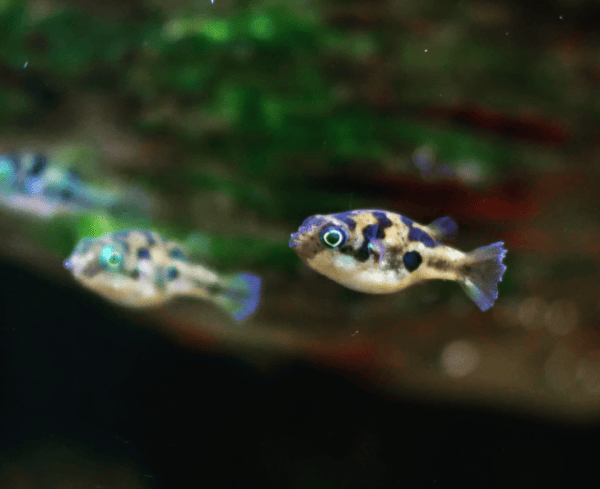
A number of frequent Pea Puffer ailments and their therapies are:
Ich
Widespread parasitic an infection that causes white spots to look. The signs often embody flashing conduct and lethargy. Therapy choices vary from elevating the water temperature to utilizing copper-based remedy.
Velvet
One other parasitic an infection, which causes a golden velvety look on the physique of the fish. Speedy respiration and lethargy are frequent signs. Treating your entire tank with copper-based remedy is taken into account an efficient remedy choice.
Fin Rot
Frayed, tattered, or eroded fins are frequent signs of fin rot. In developed phases, it could unfold to the physique of your Pea Puffer. Antibiotics and improved water circumstances are really useful remedy choices.
Truth about Pea Puffers
- Pea Puffers can tolerate barely brackish water.
- Regardless of their cute look, they are often fairly aggressive.
- Pea Puffers are snail specialists and might break by their powerful shells.
- They’re curious creatures and like to comply with the keeper across the tank.
- They like dwell meals that may be hunted and consumed.
- Particular person Pea Puffers have vibrant personalities and exhibit distinctive, entertaining conduct.
Are Pea Puffers Proper for You?
In case you can comply with this care information diligently, there is no such thing as a cause you possibly can’t preserve Pea Puffers. Though they could want particular care, Pea Puffers are fairly pleasant in direction of their human keepers.
FAQ
1. Are pea puffers exhausting to maintain?
Sure. Pea Puffers require superior care, and we don’t typically advocate them to newbie aquarists.
2. Do pea puffers eat snails?
Pea Puffers like to eat snails. Their tooth and mouth are specifically designed to interrupt and eat the shellfish.
3. Can pea puffers dwell with different fish?
They are often housed with different peaceable fish, given sufficient tank house and diet. However they don’t significantly wish to be round different members.
The Backside Line
Hopefully, you’ll now be capable of give correct care to your Pea Puffer by going by this in-depth care information. We want you all the perfect in caring on your Pea Puffers.
